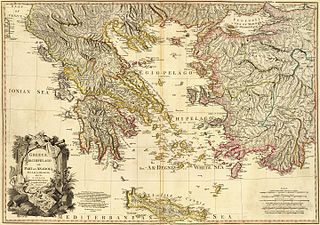 W
WThe history of Greece encompasses the history of the territory of the modern nation state of Greece as well as that of the Greek people and the areas they inhabited and ruled historically. The scope of Greek habitation and rule has varied throughout the ages and as a result the history of Greece is similarly elastic in what it includes. Generally, the history of Greece is divided into the following periods:Neolithic Greece; covering a period beginning with the establishment of agricultural societies in 7000 BC and ending in c. 3200 – c. 3100 BC.
 W
WThe Apidima Cave is a complex of four small caves located on the western shore of Mani Peninsula in southern Greece. A systematic investigation of the cave has yielded Neanderthal and Homo sapiens fossils from the Palaeolithic era.
 W
WGraecopithecus is a hominin originally identified by a single mandible found in Greece in 1944. Since then, analysis of tooth specimens, dated to 7.2 million years ago, has led to suggestions that Graecopithecus may have been the oldest direct ancestor of humans excluding the chimpanzee lineage, or alternatively the last common ancestor of both humans and chimpanzees, though other scientists are skeptical of these claims. The creature was nicknamed 'El Graeco' by scientists.
 W
WKlithi or Kleidi Cave is located to the north of the village of Kleidonia in the Ioannina regional unit and around 500 m (1,600 ft) west of the Megalakkos Cave, northwestern Greece. It is situated atop the northern bank of the Voidomatis river valley.
 W
WThe Megalakkos is a rock shelter located north of the village of Kleidonia in the Ioannina regional unit and around 500 m (1,600 ft) east of the Kleidi Cave, northwestern Greece. It sits atop the northern bank of the Voidomatis river valley.
 W
WOuranopithecus is a genus of extinct Eurasian great ape represented by two species, Ouranopithecus macedoniensis, a late Miocene hominoid from Greece and Ouranopithecus turkae, also from the late Miocene of Turkey.
 W
WOuranopithecus macedoniensis is a prehistoric species of Ouranopithecus from the Late Miocene of Greece. See more detail at Ouranopithecus.